Picturing Singapore: A Visual History
Photographs are an important means to understand Singapore’s history and heritage. Janice Loo shares highlights from the National Library’s PictureSG Collection.
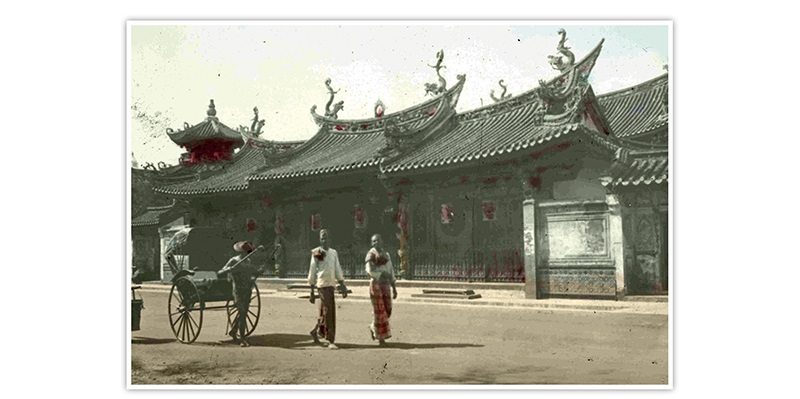 Thian Hock Keng Temple, 1900s. Located on Telok Ayer Street, Thian Hock Keng is the oldest Hokkien temple in Singapore. It began as a shrine where newly arrived Chinese immigrants gave thanks to Ma Zu (妈祖), Goddess of the Sea, for their safe voyage. Percy Hill Collection, PictureSG, National Library, Singapore.
Thian Hock Keng Temple, 1900s. Located on Telok Ayer Street, Thian Hock Keng is the oldest Hokkien temple in Singapore. It began as a shrine where newly arrived Chinese immigrants gave thanks to Ma Zu (妈祖), Goddess of the Sea, for their safe voyage. Percy Hill Collection, PictureSG, National Library, Singapore.
In one image, a man is pulling a rickshaw outside the Thian Hock Keng Temple on Telok Ayer Street. In another, Malay sailboats (or kolek) race at the harbour on New Year’s Day. In a third photograph, a family poses for a portrait in front of the National Theatre on River Valley Road.
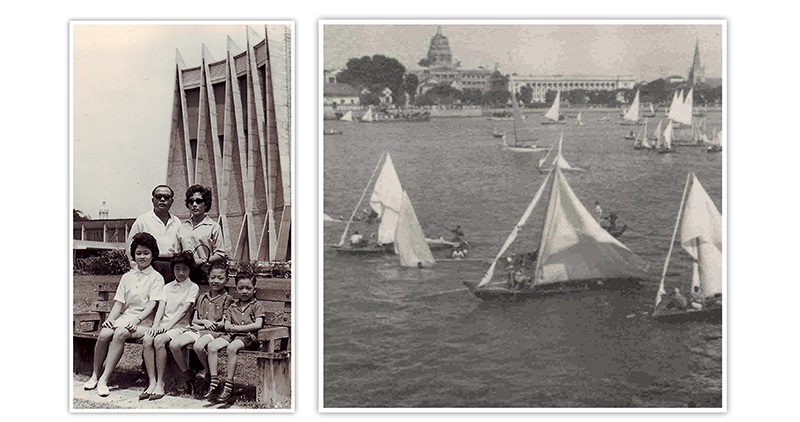 (Left) A family posing outside the National Theatre, 1965. Designed by local architect Alfred H.K. Wong, the National Theatre was built to commemorate Singapore’s attainment of self-government in 1959. The theatre was situated at the corner of Clemenceau Avenue and River Valley Road. It was closed in 1984 and subsequently demolished to make way for the Central Expressway. Donated by Chang Wei Jie Jerroy, PictureSG, National Library, Singapore. (Right) Scene of the New Year Sea Sports, 1939. This was an annual regatta that took place in the
harbour, off Collyer Quay. The Supreme Court building and Municipal Building can be seen in the background. Edwin A. Brown Collection, PictureSG, National Library, Singapore.
(Left) A family posing outside the National Theatre, 1965. Designed by local architect Alfred H.K. Wong, the National Theatre was built to commemorate Singapore’s attainment of self-government in 1959. The theatre was situated at the corner of Clemenceau Avenue and River Valley Road. It was closed in 1984 and subsequently demolished to make way for the Central Expressway. Donated by Chang Wei Jie Jerroy, PictureSG, National Library, Singapore. (Right) Scene of the New Year Sea Sports, 1939. This was an annual regatta that took place in the
harbour, off Collyer Quay. The Supreme Court building and Municipal Building can be seen in the background. Edwin A. Brown Collection, PictureSG, National Library, Singapore.All these images capture scenes of Singapore that no longer exist. The Thian Hock Keng Temple photo dates to the 1890s, hence the rickshaws. These days, kolek no longer race in the waters off Collyer Quay on New Year’s Day. And while the National Theatre is certainly Instagram-worthy, that building was demolished in 1986.
Photographs like these are why the National Library’s online PictureSG Collection is so valuable. Consisting of more than 35,000 digitised and “born-digital” (images originally shot in digital format) photographs, PictureSG allows anyone with an internet connection to explore Singapore’s history from the 19th century to modern times.
PictureSG exists because a key function of the National Library is to collect, preserve and make available the published and documentary heritage of the nation. To this end, the National Library has been acquiring, organising and digitising all manner of Singapore-related content, including monographs,1 newspapers,2 music recordings3 and photographs. Over the years, the library has created online platforms to facilitate the search and discovery of the library’s wide array of materials by format. For images and photographs, that platform is PictureSG.
Photographs of Early Singapore
Some of the oldest works in the National Library’s photograph collection were taken by early commercial photography studios – such as Sachtler & Co. and G.R. Lambert & Co. – that operated in Singapore in the 19th and early 20th centuries. These studios produced picturesque scenes and portraits of people that became popular tourist souvenirs at the time. Today, the prints serve as an invaluable source of visual documentation on early Singapore.4
Other than the works of professional photo studios, the collection also includes rare photographs from the personal collections of former European residents of Singapore. These provide another perspective on life during the colonial period.
One such collection belonged to Percy Reginald Hill (1888–1950). In 2007, his daughter Mrs Eleanor O’Hara offered the National Library her father’s collection of 60 glass slides (images printed on glass) featuring scenes of Singapore and Malaya in the early 20th century. Hill was a chartered accountant who worked for the accounting firm Evatt & Company in Singapore and Kuala Lumpur between 1906 and 1919.
A keen photographer, Hill spent his free time documenting everyday life in Malaya, including people, rubber plantations, coastal and riverine settlements, temples, tropical fruits, and street and market scenes. He apparently handcoloured some of the slides himself.5
A year later, another major donation was made by the family of Edwin A. Brown (1878–1955). The Edwin A. Brown Collection comprises some 170 photographic prints of Singapore mainly taken in the 1920s and 30s. The photographs reflect the colourful civic and cultural life of pre-war Singapore in which Brown, a businessman, participated.
Highlights of this collection include photographs of the Prince of Wales’ visit in 1922; the opening of Kallang Airport in 1937; a performance of The Pirates of Penzance at the Victoria Theatre in 1937; the opening of the King George VI Graving Dock in 1938; various scouting activities and the annual New Year’s Day regatta at Collyer Quay in the 1930s.
Modern Singapore
The majority of photographs in the National Library’s collection date to the first three decades of Singapore’s independence and were donated by prominent individuals, professional photographers as well as the general public. These images document the changing physical and social landscape as the country underwent rapid development and urbanisation.
Among the photographs of this period are the library’s own collection of prints that capture the history of library services in Singapore, including the former National Library building on Stamford Road,6 the first mobile library service started in 19607 and the first branch library in Queenstown,8 which was officially opened by founding Prime Minister Lee Kuan Yew in 1970.
The National Library also receives photographs as part of larger donations, which can include books, maps, photographers’ notes, manuscripts and other materials that provide valuable supporting information. A case in point is the donation in 2009 by the family of Lee Kip Lin (1925–2011) of some 17,000 photographic materials, making up the single largest collection of images in PictureSG. In addition to rare prints by G.R. Lambert & Co. and photos of modern Singapore personally taken by Lee himself, the Lee Kip Lin Collection also includes monographs and maps of Singapore and Southeast Asia.
Lee was an architectural historian, educator and professional architect. His passion for Singaporean architectural history led him to research and publish several books on the subject, including his seminal work The Singapore House: 1819–1942,9 first published in 1988 and reprinted in 2015.
An advocate of conservation, Lee undertook extensive photographic surveys to support his cause. Between 1965 and 1995, Lee traversed the island documenting streets, buildings and places in a methodical fashion, and where possible, from exterior to interior views. The outcome of this painstaking endeavour is a meticulous visual record of Singapore’s architectural heritage and spatial transformation over a 30-year period. Most of the photographs were shot on black-and-white film, which rendered architectural details with greater contrast and clarity compared to colour film.10
In addition to the quality of the photographs, the value of the Lee Kip Lin Collection lies in its diverse subject matter. The photos were taken in the city centre as well as outlying areas, and showcase a variety of building types such as bungalows, shophouses, markets, flats, schools and places of worship. Studied together with maps, building plans and other historical records in the National Library’s collections, the photographs allow the viewer to reconstruct the past through places and spaces in Singapore that have been altered beyond recognition or no longer exist today.
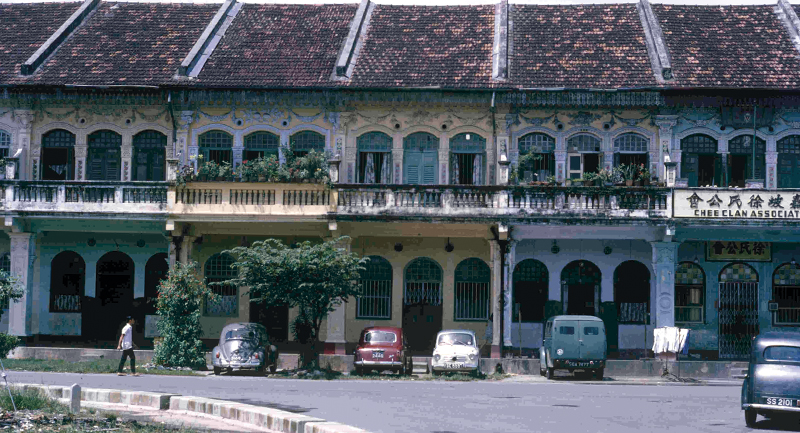 A row of two-storey shophouses on Kitchener Road, 1966. These dwellings have typical Peranakan features such as the half-length swinging doors (pintu pagar) at the entrance. Lee Kip Lin Collection, PictureSG, National Library, Singapore.
A row of two-storey shophouses on Kitchener Road, 1966. These dwellings have typical Peranakan features such as the half-length swinging doors (pintu pagar) at the entrance. Lee Kip Lin Collection, PictureSG, National Library, Singapore.
Another collection of photographs that showcase Singapore’s architecture was donated in 2007 by the family of Kouo Shang-Wei (1924–88). The Kouo Shang-Wei Collection comprises over 6,700 photographic prints, slides and negatives.11 Kouo was a talented photographer and a pioneer in the art photography scene of Singapore and Malaya. His contemporaries include well-known names such as K.F. Wong,12 Yip Cheong Fun13 and Lee Lim.
Kouo captured streetscapes and panoramic views of the Singapore River, the Marina Bay area and Raffles Place from the 1950s to the 80s. Highlights of the collection are photographs of buildings that have become enduring downtown icons, such as OCBC Centre (Kouo was commissioned to photograph the construction and opening of this building). Designed by renowned architect I.M. Pei, the 52-storey building was the tallest in Southeast Asia when it was completed in 1976.
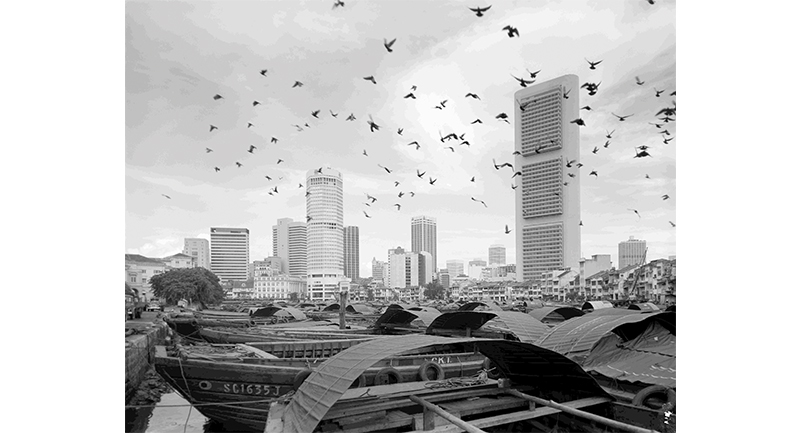 In 1984, this dramatic shot by Kouo Shang-Wei bagged him the first prize in the Singapore Cityscape Today photo competition organised by the Urban Redevelopment Authority. The photo shows pigeons in flight against the backdrop of skyscrapers like OCBC Centre and UOB Plaza in the Central Business District in the 1970s. In the foreground are bumboats clustered along the Singapore River. Kouo Shang-Wei Collection, PictureSG, National Library, Singapore.
In 1984, this dramatic shot by Kouo Shang-Wei bagged him the first prize in the Singapore Cityscape Today photo competition organised by the Urban Redevelopment Authority. The photo shows pigeons in flight against the backdrop of skyscrapers like OCBC Centre and UOB Plaza in the Central Business District in the 1970s. In the foreground are bumboats clustered along the Singapore River. Kouo Shang-Wei Collection, PictureSG, National Library, Singapore.
Kouo’s streetscapes document itinerant trades that were once common sights in Singapore, such as trishaw riders, storytellers, letter writers, calligraphers and satay vendors. The collection also includes photographs of various National Day celebrations, samsui women at work in the 1980s as well as the newly constructed Marine Parade estate – Singapore’s first public housing project built on reclaimed land.
Another notable part of the PictureSG Collection is a donation by French photographer Paul Piollet in 2013. Piollet contributed 160 colour slides featuring scenes of Singapore taken from the 1970s to the 90s, particularly of the Chinatown area. These photographs document the social life as well as the cultural and religious practices that are no longer seen in the city centre today. These include Teochew opera (including shots of the performers on stage, backstage as well as the audience), funeral processions, businesses operating along five-footways and hawkers.
Performing Arts Photographs
The National Library also has a collection of more than 4,500 images capturing the activities of local arts groups and organisations, with the majority of them coming from established Chinese performing arts groups. These materials were received as part of larger donations that included publications, ephemera, and audio and video recordings.
In 2008, the National Library obtained permission to digitise some 1,000 photographs and publications from the Thau Yong Amateur Musical Association (陶融儒乐社). The association was formed in 1931 and continues to stage regular performances of Waijiang (外江)14 and Teochew opera and music today.15 The collection comprises photographs of the association’s members, costumes, performances, stage design and anniversary events.
In 2014, the Singapore Children’s Playhouse (新加坡儿童剧社), a Mandarin theatre group for children and youths, donated over 1,500 photographs and about 100 other items comprising books, brochures, periodicals, sound recordings, certificates, reels and vinyl records to the National Library. These materials document the performances and theatre productions of the group from the 1960s to the 80s. That same year, the National Library also received some 500 images from Siong Leng Musical Association (湘音社), which has been actively promoting traditional Nanyin music (南音) and Liyuan (梨園) opera16 in Singapore since its founding in 1941. The association remains active today and has won international awards for its performances.
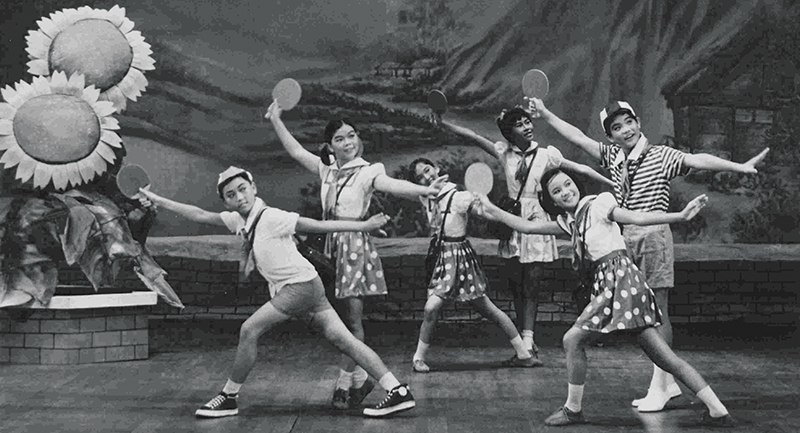 我们爱打乒乓球 (Wo men ai da ping pang qiu; “We Love to Play Ping Pong”) by the Singapore Children’s Playhouse at Victoria Theatre, February 1975. Singapore Children’s Playhouse Collection, PictureSG, National Library, Singapore.
我们爱打乒乓球 (Wo men ai da ping pang qiu; “We Love to Play Ping Pong”) by the Singapore Children’s Playhouse at Victoria Theatre, February 1975. Singapore Children’s Playhouse Collection, PictureSG, National Library, Singapore.
The library received a major donation of arts-related materials from The Substation, Singapore’s first independent contemporary arts centre, in 2015. Comprising 2,700 items, The Substation Collection comprises publications, print and digital photographs, sound recordings and ephemera. The materials chronicle the activities of The Substation since its founding in 1990 by playwright-dramatist and Cultural Medallion recipient Kuo Pao Kun.17
The 1,600 print and digital images in this collection provide visual documentation of over 150 events, programmes, exhibitions and performances held at The Substation from 1990 to 2013. The collection is useful to researchers who wish to trace the development of the contemporary art scene, artists, arts programming and independent art spaces in Singapore.
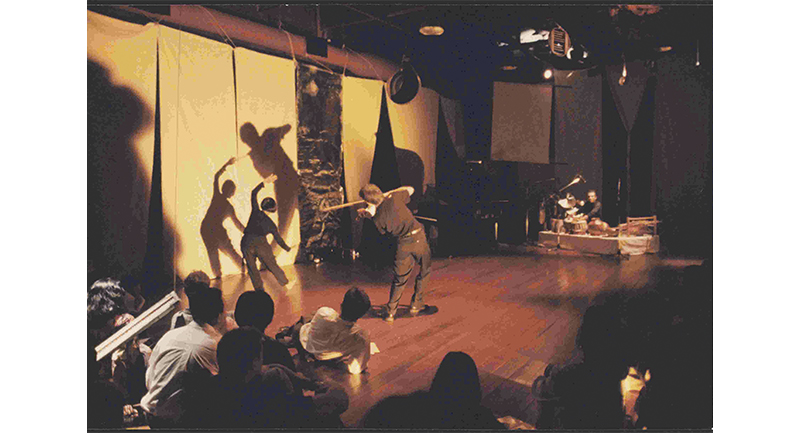 The “Harmony of the Spheres” performance held at The Substation‘s Music Space from 18 to 20 July 1997. The Substation Collection, PictureSG, National Library, Singapore.
The “Harmony of the Spheres” performance held at The Substation‘s Music Space from 18 to 20 July 1997. The Substation Collection, PictureSG, National Library, Singapore.
Public Contributions
In 2007 and 2008, the library organised a series of Heritage Roadshows during which people were invited to contribute photographs of historic buildings, landmarks, places and street scenes of Singapore from before the 1980s.
About 800 photographs – mainly of family events, everyday life and leisure activities – were loaned to the library for digitisation. Unlike documentary or professional photography, such images were created in the course of daily life and were intended as personal keepsakes. Many of the scenes depict individuals, groups and families posing at places of attraction and landmarks that no longer exist, such as the National Theatre, Van Kleef Aquarium and Great World Amusement Park. Photographs of kampongs and old-style dwellings capture living conditions of the past and a bygone way of life that has since given way to the modern-day high-rise living in public housing flats.
These photographs provide insights into Singaporean life, society and popular culture from the 1950s to the 70s gleaned from the intimate perspectives of personal and family photographs.
Picturing the Future
Today, images of Singapore are being created and disseminated at an unprecedented speed and volume due to the widespread use of smartphone cameras and the proliferation of social media platforms such as Instagram. While technology has made it easier to capture scenes of events as they unfold, such photographs are transient and may be difficult to locate subsequently unless they are properly indexed and archived.
In seeking to build a robust pictorial record of Singapore, the challenge today lies in handling this deluge with the help of technology to sift through, select, describe and organise an ever-increasing number of images for discovery, learning and research.
| THE MAKING OF PICTURESG |
| Photographs form part of the special materials collection at the National Library. As photographs of Singapore are generally difficult to find on the market, the library has made concerted efforts to grow its photograph collection through donations by individuals, groups and organisations in addition to acquisitions. |
| The National Library is interested in collecting photographs that document national events and the activities of notable individuals and organisations in Singapore, including those that chronicle themes of national significance such as urban redevelopment, or are representative of Singapore society in a particular time period. These photographs tend to mostly remain in private collections or are held in organisational archives. |
| The National Library has put in place a Donors Programme to promote the library’s mission of collecting and preserving published and unpublished materials of national significance and heritage value. |
| The library collects works by both professional and amateur photographers. The main criteria for selection is that they must contain documentary or historical content about Singapore. As photographs are important for their informational and evidential value, preference is given to those that capture the subject with accuracy and detail, and include information such as dates, locations and names. |
| Reproductions or duplicates of original photographs are only accepted in exceptional circumstances, such as when the original cannot be obtained or is in poor condition. In evaluating an item, the library also considers its physical condition and its suitability for long-term preservation. |
| To make its collections accessible, the National Library launched an online database of visual materials on Singapore as early as 2005. Known as Singapore Pictures, the website started with some 400 contemporary and historical images covering a variety of subjects, ranging from nature and landscapes to prominent personalities and historical events in Singapore. In 2008, the database was renamed Singapore National Album of Pictures (SNAP). |
| Initially, the digital image collection was made up primarily of photographs featuring places of interest, buildings and monuments in Singapore taken by the staff of the NationalLibrary in the course of their work.18 These were captioned and uploaded on the SNAP portal. In 2008, to reach out to more users, the library collaborated with Flickr – a photo-sharing website – to mirror the SNAP collection on its site. This helped to raise the visibility and accessibility of the SNAP collection through better search engine indexing and enabled the public to contribute additional information about the images as well as share these photographs on social media platforms such as Facebook and Twitter. |
| In 2011, SNAP was revamped and relaunched as PictureSG.19 The collection has since grown substantially due to donations and public contributions. |
| Among the new features that improved the usability of the PictureSG database is the inclusion of thumbnails in the search results, which reduced the number of clicks needed to access the desired image. Previously, the search results in SNAP were limited to text descriptions and users had to click on each link to ascertain if the image matched what they were looking for. |
| The photograph collection of the National Library complements that of the National Archives of Singapore (NAS) and other collecting institutions in Singapore. To promote content discovery across collections, text analytics are used to recommend related images within PictureSG as well as those from the NAS.20 In addition, PictureSG images are featured on other National Library websites such as Singapore Infopedia, an electronic encyclopedia of articles about Singapore. |
| OneSearch is another platform that provides access to PictureSG resources. This online portal facilitates the search and retrieval of resources from the National Library Board’s library and archives databases as well as those from the National Heritage Board’s repository of artefacts and artworks held by its museums. |
| In PictureSG, each image comes with its own metadata,21 which includes its title, estimated date of creation, name of creator, a brief description, the subject and a rights statement. In describing and captioning each item, library staff rely on the original accompanying caption or notes and conduct some research to verify the information. The title describes the subject depicted, and contains the date and the orientation of the image – for example, whether it is a general view, an interior or exterior view, a close-up – as well as the estimated date of creation. |
| Members of the public have occasionally written in to provide feedback or make enquiries about image descriptions. The feedback received thus far tends to address inaccuracies rather than provide supplementary information. When feedback is received, library staff verify the claims and amend the metadata if necessary. This process can be onerous as image research often requires cross-referencing with other images of the same location from different time periods. Furthermore, the information provided by the user is sometimes based on tacit knowledge, for example, the user’s own experience or family history, and this can be challenging to verify in the absence of readily available documentary sources. |
| One way to make it more convenient for the public to help enrich content is to enable crowdsourced annotations. This is being done by the National Archives via its Citizen Archivist Project, where the public is encouraged to contribute by providing descriptions of photographs and transcribing documents in the archives’ collections. |
 Janice Loo is a Librarian with the National Library, Singapore. Her responsibilities include collection management and content development as well as research and reference assistance on topics relating to Singapore and Southeast Asia.
Janice Loo is a Librarian with the National Library, Singapore. Her responsibilities include collection management and content development as well as research and reference assistance on topics relating to Singapore and Southeast Asia.
NOTES
-
BookSG is a collection of books and other printed materials digitised from the collections of the National Library of Singapore, and complemented by selected works from The British Library’s Oriental & India Office Collection (http://eresources.nlb.gov.sg/printheritage). ↩
-
NewspaperSG is an online resource of current and archived newspapers from Singapore and Malaya (http://eresources.nlb.gov.sg/newspapers). ↩
-
NORA (National Online Repository of the Arts) is a collection of digitised works in the areas of literary, performing and visual arts by prominent Singaporean artists. Notable collections in NORA include the digital archive of Singapore Tamil theatre, music and dance, which features digitised and born-digital photographs, recordings, ephemera and publications (http://eresources.nlb.gov.sg/arts). ↩
-
Loo, J. Daguerreotypes to dry plates: Photography in 19th-century Singapore. BiblioAsia 15, no. 3 (October -December 2015). Retrieved from BiblioAsia website. ↩
-
National Library Board. (2013, June 26). Percy Reginald Hill written by Duncan Suntherland. Retrieved from Singapore Infopedia website; Low, E. (2008, July). The Percy R Hill Collection. BiblioAsia, 4 (2), 56–57. ↩
-
National Library Board. (2020, June). National Library (1960–1979) written by Goh Lee Kim. Retrieved from Singapore Infopedia website. ↩
-
National Library Board. (1999). Mobile Library Services (1960-1991) written by Wong Heng and Thulaja Naidu. Retrieved from Singapore Infopedia website. ↩
-
National Library Board. (2000). Queenstown Community Library written by Wong Heng. Retrieved from Singapore Infopedia website. ↩
-
Lee, K.L. (1988). The Singapore House: 1819–1942. Singapore: Times Editions for Preservation of Monuments Board. (Call no.: RSING 728.095957 LEE); Lee, K.L. (2015). The Singapore House: 1819–1942. Singapore: Marshall Cavendish Editions and National Library Board. (Call no.: RSING 728.095957 LEE) ↩
-
Lai, C.K. (2015). Through the lens of Lee Kip Lin: Photographs of Singapore 1965–1995 (pp. 10–11, 22). Singapore: National Library Board and Editions Didier Millet. (Call no.: RSING 779.45957 LAI) ↩
-
National Library Board. (2009). Kouo Shang Wei written by Nurhaizatul Jamila Jamil. Retrieved from Singapore Infopedia website; Zhuang, W.B. (2018). Shifting currents: Glimpses of a changing nation. Singapore: National Library Board and Marshall Cavendish Editions. (Call no.: RSING 915.957 KUO) ↩
-
Zhuang, W.B. (2019, Jul–Sep). From the archives: The work of photographer K.F. Wong. BiblioAsia, 15 (2). Retrieved from BiblioAsia website. Select photographs by K.F. Wong are available at the National Archives of Singapore and can be viewed via the Archives Online portal. ↩
-
Tan B.T. (2006). An ingenious reverie: The photography of Yip Cheong Fun. Singapore: National Library Board and Singapore Heritage Society. (Call no.: RSING 779.092 TAN) ↩
-
Waijiang music and opera originated from Northern China and later came to be enjoyed by the Teochew community in Chaoshan (southeastern part of Guangdong province) and Singapore by the end of the 19th century. See Chua, S.P. (2019). Chinese performing arts (p. 579). In C.G. Kwa & B.L. Kua. (Eds.), A general history of the Chinese in Singapore. Singapore: Singapore Federation of Chinese Clan Associations; World Scientific. (Call no.: RSING 305.895105957 GEN) ↩
-
National Library Board. (2016). Thau Yong Amateur Musical Association written by Alvin Chua. Retrieved from Singapore Infopedia website. ↩
-
Nanyin music and Liyuan opera are traditional musical and performance arts genres of the Minnan or Hokkien dialect group from southern Fujian province in China. Retrieved from UNESCO website. ↩
-
National Library Board. (2016). The Substation written by Heman Chong. Retrieved from Singapore Infopedia website. ↩
-
Ang, S.H., & Pwee, T. (2008). Working with the public: Flickr SNAP (Singapore National Album of Pictures). CDNLAO Newsletter, 63. Retrieved from National Diet Library website. ↩
-
Ng, H.L. (2012). A visual memoir of Singapore: PictureSG. CDNLAO Newsletter, 73. Retrieved from National Diet Library website. ↩
-
Kia, S.H., Liau, Y.C., & Ong, I. (2016). Interconnected network of knowledge: The NLB journey. In L. Bultrini, S. McCallum, W. Newman, W., & J. Sempéré. (Eds.), Knowledge management in libraries and organizations (pp. 87–102). Berlin/Munich: De Gruyter Saur. ↩
-
A set of data that describes and gives information about other data. ↩

